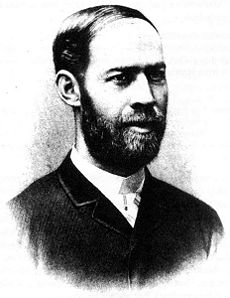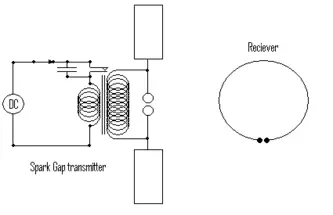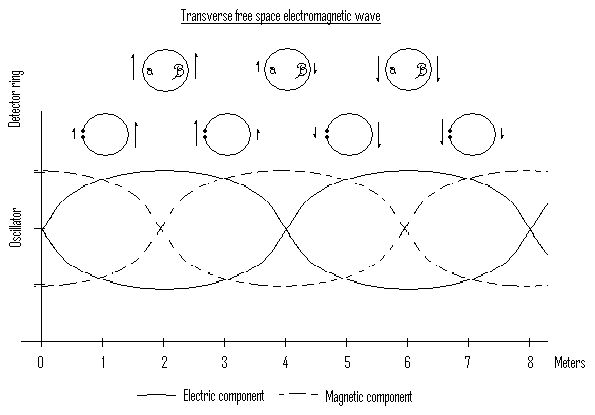Heinrich Hertz
|
Heinrich Rudolf Hertz | |
|---|---|
 "I do not think that the wireless waves I have discovered will have any practical application."
| |
| Born |
February 22, 1857 |
| Died | January 1, 1894 Bonn, Germany |
| Residence | |
| Nationality | |
| Field | Physicist and Electronic Engineer |
| Institutions | University of Kiel University of Karlsruhe University of Bonn |
| Alma mater | University of Munich University of Berlin |
| Academic advisor | Hermann von Helmholtz |
| Known for | Electromagnetic radiation |
Heinrich Rudolf Hertz (February 22, 1857 - January 1, 1894) was the German physicist and mechanician for whom the hertz, an SI unit, is named. In 1888, he was the first to satisfactorily demonstrate the existence of electromagnetic radiation by building an apparatus to produce and detect UHF radio waves.
Biography
Early years
Heinrich Rudolf Hertz was born in Hamburg, Germany on February 22, 1857, the oldest of five children of Gustav Ferdinand Hertz and Anna Elisabeth Pfefferkorn. Hertz's paternal grandfather converted from Judaism to Lutheranism and married into a Lutheran family. His father was an attorney who belonged to the Hamburg senate, his mother the daughter of a doctor. Both Hertz's father and mother were Lutheran.
In his youth, Hertz showed an advanced aptitude for mathematics, and took extra geometry lessons on Sundays. He was always ranked first in his class. He also had a strong affinity for languages, quickly learning Latin, Greek, Arabic and Sanskrit. He studied sciences and engineering in the German cities of Dresden, Munich and Berlin. At the same time, he showed a facility for the practical in drawing, sculpture and handicraft. He was a student of Gustav R. Kirchhoff and Hermann von Helmholtz. He obtained his PhD in 1880, and remained a pupil of Helmholtz until 1883 when he took a post as a lecturer in theoretical physics at the University of Kiel. In 1885 he became a full professor at the University of Karlsruhe where he discovered electromagnetic waves.
Meteorology
Hertz had always had a deep interest in meteorology probably derived from his contacts with Willhelm von Bezold (he was Hertz's professor in a laboratory course at the Munich Polytechnic in the summer of 1878). Hertz, however, did not contribute much to the field himself except for some early articles as an assistant to Helmholtz in Berlin, including research on the evaporation of liquids, a new kind of hygrometer, and a graphical means of determining the properties of moist air when subjected to adiabatic changes. [1]
Contact mechanics
In 1881–1882, Hertz published two articles on what was to become known as the field of contact mechanics. Hertz is generally well known for his contributions to the field of electrodynamics (see below) however most papers that look into the fundamental nature of contact cite his two papers as a source for some important ideas. Boussinesq published some critically important observations on Hertz's work, nevertheless establishing this work on contact mechanics to be of immense importance. His work basically summarises how two axi-symmetric objects placed in contact will behave under loading, he obtained results based upon the classical theory of elasticity and continuum mechanics. The most significant failure of his theory was the neglect of any nature of adhesion between the two solids, which proves to be important as the materials composing the solids start to assume high elasticity. But it was natural to neglect adhesion in that age as there were no experimental methods by which they could test for adhesion. To develop his theory Hertz used his observation of elliptical Newton's rings formed upon placing a glass sphere upon a lens as the basis of assuming that the pressure exerted by the sphere follows an elliptical distribution. He used the formation of Newton's rings again while validating his theory with experiments in calculating the displacement which the sphere has into the lens. K. L. Johnson, K. Kendall and A. D. Roberts (JKR) used this theory as a basis while calculating the theoretical displacement or indentation depth in the presence of adhesion in their landmark article in the Journal of Colloid and Interface Science in 1971. Hertz's theory is recovered from their formulation if the adhesion of the materials is assumed to be zero. Similar to this theory, however using different assumptions, B. V. Derjaguin, V. M. Muller and Y. P. Toporov published another theory in 1975, which came to be known as the DMT theory in the research community, which also recovered Hertz's formulations under the assumption of zero adhesion. This DMT theory proved to be rather premature and needed several revisions before it came to be accepted as another material contact theory in addition to the JKR theory. Both the DMT and the JKR theories form the basis of contact mechanics upon which all transition contact models are based and used in material parameter prediction in Nanoindentation and Atomic Force Microscopy. So Hertz's research from his days as a lecturer, preceding his great work on electromagnetism, which he himself considered with his characteristic soberness to be trivial, has come down to the age of nanotechnology.
Electromagnetic research
Hertz helped establish the photoelectric effect (which was later explained by others) when he noticed that a charged object loses its charge more readily when illuminated by ultraviolet light. In 1887, he made observations of the photoelectric effect and of the production and reception of electromagnetic (EM) waves, published in the journal Annalen der Physik. His receiver consisted of a coil with a spark gap, whereupon a spark would be seen upon detection of EM waves. He placed the apparatus in a darkened box in order to see the spark better; he observed, however, that the maximum spark length was reduced when in the box. A glass panel placed between the source of EM waves and the receiver absorbed ultraviolet radiation that assisted the electrons in jumping across the gap.
When removed, the spark length would increase. He observed no decrease in spark length when he substituted quartz for glass, as quartz does not absorb UV radiation. Hertz concluded his months of investigation and reported the results obtained. He did not further pursue investigation of this effect, nor did he make any attempt at explaining how the observed phenomenon was brought about.
Earlier in 1886, Hertz developed a dipole antenna. This antenna is a center-fed driven element for transmitting or receiving radio frequency energy. These antennas are the simplest practical antennas from a theoretical point of view. In 1887, Hertz experimented with radio waves in his laboratory. These actions followed Michelson's 1881 experiment (precursor to the 1887 Michelson-Morley experiment) which did not detect the existence of aether drift, Hertz altered the Maxwell's equations to take this view into account for electromagnetism. Hertz used a Ruhmkorff coil-driven spark gap and one meter wire pair as a radiator. Capacity spheres were present at the ends for circuit resonance adjustments. His receiver, a precursor to the dipole antenna, was a simple half-wave dipole antenna for shortwaves.
Through experimentation, he proved that transverse free space electromagnetic waves can travel over some distance. This had been predicted by James Clerk Maxwell and Michael Faraday. With his apparatus configuration, the electric and magnetic fields would radiate away from the wires as traverse waves. Hertz had positioned the oscillator about 12 meters from a zinc reflecting plate to produce standing waves. Each wave was about four meters. Using the ring detector, he recorded how the magnitude and wave's component direction vary. Hertz measured Maxwell's waves and demonstrated that the velocity of radio waves was equal to the velocity of light. The electric field intensity and polarity was also measured by Hertz.
The Hertzian cone was first described by Hertz as a type of wave-front propagation through various media. His experiments help expand the field of electromagnetism transmission and his apparatus was developed further by others in the history of radio. Hertz also found that radio waves could be transmitted through different types of materials, and were reflected by others. This was key to radar and was investigated and exploited later by others. Hertz did not understand the practical importance of his experiments. He stated that,
- "It's of no use whatsoever[...] this is just an experiment that proves Maestro Maxwell was right - we just have these mysterious electromagnetic waves that we cannot see with the naked eye. But they are there." [2]
Asked about the ramifications of his discoveries, Hertz replied,
- "Nothing, I guess." [2]
His discoveries would later be more fully understood by others and be part of the new "wireless age." In bulk, Hertz' experiment explain reflection, refraction, polarization, interference, and velocity of electric waves.
In 1892, Hertz began experimenting and demonstrated that cathode rays could penetrate very thin metal foil (such as aluminium). Philipp Lenard, a student of Heinrich Hertz, further researched this "ray effect." He developed a version of the cathode tube and studied the penetration by X-rays of various materials. Philipp Lenard, though, did not realize that he was producing X-rays. Hermann von Helmholtz formulated mathematical equations for X-rays. He postulated a dispersion theory before Röntgen made his discovery and announcement. It was formed on the basis of the electromagnetic theory of light (Wiedmann's Annalen, Vol. XLVIII). However, he did not work with actual X-rays.
Death and afterwards
In 1892, an infection was diagnosed (after a bout of severe migraines) and Hertz underwent some operations to correct the illness. He died of blood poisoning at the age of 36 in Bonn, Germany. His nephew Gustav Ludwig Hertz was a Nobel Prize winner, and Gustav's son Carl Hellmuth Hertz invented medical ultrasonography.
The SI unit hertz (Hz) was established in his honor by the IEC in 1930 for frequency, a measurement of the number of times that a repeated event occurs per unit of time (also called "cycles per sec" (cps)). In 1969 (East Germany), there was cast a Heinrich Hertz memorial medal. The IEEE Heinrich Hertz Medal, established in 1987, is "for outstanding achievements in Hertzian waves [...] presented annually to an individual for achievements which are theoretical or experimental in nature." It was adopted by the CGPM (Conférence générale des poids et mesures) in 1964. A crater that lies on the far side of the Moon, just behind the eastern limb, is named in his honor.
See also
|
People
Lists and histories
|
Other
|
Notes
- ↑ J. F. Mulligan and H. G. Hertz, "On the energy balance of the Earth," American Journal of Physics, vol. 65, pp 36-45
- ↑ 2.0 2.1 Eugenii Katz, "Heinrich Rudolf Hertz." Biographies of Famous Electrochemists and Physicists Contributed to Understanding of Electricity, Biosensors & Bioelectronics.
ReferencesISBN links support NWE through referral fees
<<Please format all references according to our guidelines.>>
- Appleyard, Rollo, "Pioneers of electrical communication." London, Macmillan and co., limited, 1930. LCCN 30011090 //r87 ( ed. memoirs were published in Electrical communication.)
- Bodanis, David. Electric Universe: How Electricity Switched on the Modern World. New York: Three Rivers Press, 2005. ISBN 0-307-33598-4
- Buchwald, Jed Z., "The creation of scientific effects : Heinrich Hertz and electric waves." Chicago : University of Chicago Press, c1994. ISBN 0-226-07887-6 (alk. paper) ISBN 0-226-07888-4 (pbk.; alk. paper) LCCN 93041783
- Susskind, Charles, "Heinrich Hertz : a short life." San Francisco, CA : San Francisco Press, c1995. ISBN 0-911302-74-3
- Lodge, Oliver, "The work of Hertz and his successors : being a description of signalling across space without wires by electric waves, "The Electrician" series. Signalling without wires. London : "The Electrician" Printing and Pub. Co., [1897?], 2nd ed.
- Bryant, John H., "Heinrich Hertz, the beginning of microwaves : discovery of electromagnetic waves and opening of the electromagnetic spectrum by Heinrich Hertz in the years 1886-1892." New York : Institute of Electrical and Electronics Engineers ; Piscataway, NJ : IEEE Service Center, Single Publication Sales Dept. [distributor], c1988. ISBN 0-87942-710-8 LCCN 88176362 (ed. 1988 IEEE/MTT-S Hertz Centennial Celebration exhibition at the 1988 MTT-S International Microwave Symposium)
- Baird, Davis. (ed.), Hughes, R. I. G. (ed.), and Nordmann, Alfred, (ed.), "Heinrich Hertz : classical physicist, modern philosopher." Boston studies in the philosophy of science. v. 198, Dordrecht ; Boston : Kluwer Academic Publishers, c1998. ISBN 0-7923-4653-X (hardcover; alk. paper) LCCN 97023406
- Ducretet, E., "La télégraphie hertzienne sans fils : expériences de Henri Hertz" (Tr., Hertzian telegraphy without wire: experiments of Henri Hertz). Guise (Aisne) : s.n., 1898 (Baré)
- Maugis, D., "Contact, Adhesion and Rupture of Elastic Solids." ISBN 3-540-66113-1, (Springer-Verlag)
External links
- Kim Breitfelder (Program Manager) and Mike Geselowitz, (Director), "Heinrich Hertz." IEEE History Center, IEEE 2006.
- John D. Jenkins, "The Discovery of Radio Waves - 1888; Heinrich Rudolf Hertz (1847-1894)." sparkmuseum.com.
- Francesco Errante, "Hertzian Radiation, (better known as radio-waves) : what it is and how it happens." Radiondistics.com.
- Russell Naughton, "Heinrich Rudolph (alt: Rudolf) Hertz, Dr : 1857 - 1894." Adventures in CyberSound.
- "Heinrich Rudolf Hertz." Institute of Experimental Physics, University of Debrecen.
- Wilhelm Mosel, "Buildings Integral to the Former Life and/or Persecution of Jews in Hamburg - Eimsbüttel/Rotherbaum." Deutsch-Jüdische Gesellschaft, Hamburg.
- "Heinrich Hertz." The First Electronic Church of America.
- "Heinrich Rudolph Hertz (1857 - 1894)." Corrosion-doctors.org.
- Struan Robertson, "Heinrich Hertz (1857 - 1894)." uni-hamburg.de. (ed. Hertz' portrait in the Hamburg City Hall.)
- Electric waves: being researches on the propagation of electric action with finite velocity through space by Heinrich Rudolph Hertz. Cornell University Library Historical Monographs Collection. {Reprinted by} Cornell University Library Digital Collections
| Persondata | |
|---|---|
| NAME | Hertz, Heinrich Rudolf |
| ALTERNATIVE NAMES | |
| SHORT DESCRIPTION | Physicist and Electronic Engineer |
| DATE OF BIRTH | February 22, 1857 |
| PLACE OF BIRTH | Hamburg, Germany |
| DATE OF DEATH | January 1, 1894 |
| PLACE OF DEATH | Bonn, Germany |
Credits
New World Encyclopedia writers and editors rewrote and completed the Wikipedia article in accordance with New World Encyclopedia standards. This article abides by terms of the Creative Commons CC-by-sa 3.0 License (CC-by-sa), which may be used and disseminated with proper attribution. Credit is due under the terms of this license that can reference both the New World Encyclopedia contributors and the selfless volunteer contributors of the Wikimedia Foundation. To cite this article click here for a list of acceptable citing formats.The history of earlier contributions by wikipedians is accessible to researchers here:
The history of this article since it was imported to New World Encyclopedia:
Note: Some restrictions may apply to use of individual images which are separately licensed.


